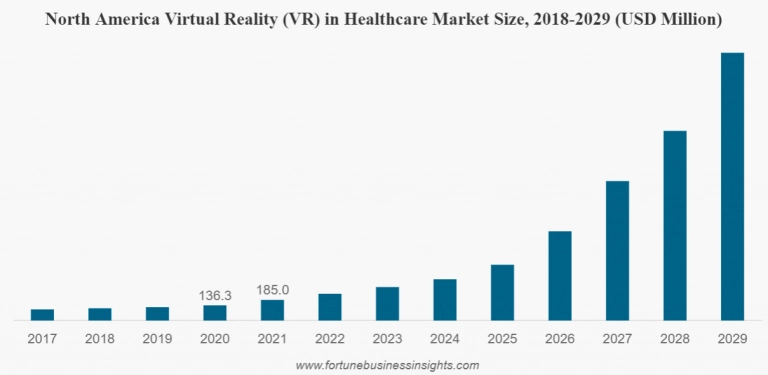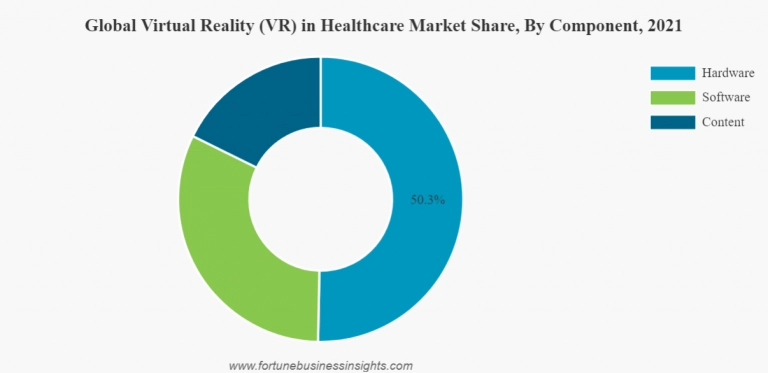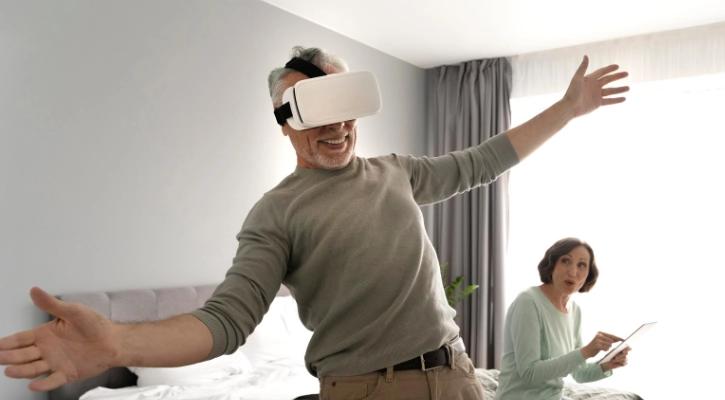Virtual reality in digital therapeutics is used to aid the treatment of management of various conditions, including pain management in patients with strokes, treatment of PTSD, OCD, anxiety disorders, and substance abuse. Virtual reality has excellent prospects because it creates immersive digital video environments in which patients engage in a controlled manner. The market of VR in digital therapeutics will experience intense growth throughout the 2020s, leading to new implementations of VR in treatments. This article focuses on the advantages of using VR in treatment, areas of application, real-life implementations of VR DTx, and potential challenges.
Potential of VR in DTx
VR in digital therapeutics is currently on the rise, and its potential is yet to be explored to a full capacity. A study by Fortune Business Insights confirms that virtual reality in the healthcare market was valued at $ 459 million in 2021. The projected CAGR of this market for 2022- 2029 is 38.7%. The expected price of VR in healthcare by the end of this period is $628 million. Virtual reality in digital therapeutics occupies a large portion of this market. The digital therapeutics (DTx) market itself is valued at $ 4.5 billion as of 2022 (source ).

By application, the highest-growing sector of VR for healthcare is pain management. By component, hardware is the most significant market segment at 50.3%, followed by software and content.

The leading market for VR-based healthcare solutions is North America. A good investment market can fund many startups and lead to VR technology development in the United States.
Science does not fall behind as well. As of 2023, Clinical Trials lists over 1500 active or completed studies related to VR for healthcare and VR-based treatments, including VR in digital therapeutics.
Create groundbreaking DTx solutions with us
Advantages of VR in treatment
Digital health investments in VR are worth every dollar considering what VR-based therapies are capable of. Their ability to improve patient engagement and outcomes is well-documented. Here are the couple of ways in which VR and digital therapeutics deliver:
Improving patient engagement through VR
According to the study on patients' experience with VR technologies during the Covid-19 pandemic, 91% of patients reported being satisfied with in-person care. Improving patient engagement can lead to better motivation of patients and improved outcomes. Patient engagement is improved by introducing game-like elements that make the experience more enjoyable for patients. VR therapy also means personalization, transparent goal setting, and introducing the elements of social interactions through things like virtual group therapy sessions. For example, patient engagement can be improved by making goals more tangible and easier to follow.
Enhancing treatment outcomes with VR
VR-based DTx is capable of enhancing treatment outcomes through personalized care, new treatments, introduction of data-driven insights, and cost reduction. VR treatments can be catered for specific treatment goals and be altered depending on the progress of the treatment. For example, the apps can have integrated real-time feedback that accesses the symptoms of disease in real time and adjusts accordingly. Healthcare professionals can use data from VR devices to change treatment plans. The price of treatment can also be reduced if the implementation of VR treatment is right. For instance, VR-enhanced online group psychotherapy is cheaper for the patients than real-life group psychotherapy.
VR therapy for pain management
Pain management is the highest growing sector of VR-based digital therapeutics because of the promising treatment outcomes it demonstrates. According to the research results, VR-based therapies are an effective tool in the treatment of chronic pain and severe acute pain . Another study showed a positive effect of VR-based digital neurotherapeutics for improving body structure function and activity in stroke patients. VR in digital therapeutics can simulate exercises that improve physical function and reduce pain. Moreover, VR tools can be integrated with real-time feedback that monitors physiological responses and helps control them.
VR in mental health treatment
Aside from pain management, mental health treatments is the area of VR implementation with the strongest potential. With DTx in mental health, promising treatments and new technologies related to mental health emerge all the time. The spectrum of conditions that are helped by VR interventions includes anxiety disorders, depression, PTSD, OCD, phobias, and eating disorders. Exposure therapy is one of the most apparent ways VR is used for mental health treatment. In exposure therapy, a person is exposed to a fear-inducing situation to help control their fears. Virtual reality provides a perfect setting for this, as it offers a controlled environment where the stimuli can be explored gradually.
VR-assisted cognitive behavioral therapy
VR-assisted cognitive behavioral therapy integrates all traditional cognitive behavioral therapy elements and combines them with virtual reality elements. As traditional CBT aims to change negative behavior patterns and confront maladaptive beliefs, VR is a great assistant by creating immersive environments that challenge cognitive patterns. According to research , VR CBT treatments positively impact patients with anxiety disorders, including anxiety and depression.
VR in addiction treatment
VR-based solutions are actively used in the treatment of different addictions, including alcohol addiction and all types of drug addiction. VR is an effective additional tool in addiction treatment, as the study suggests. In particular, it is effective for the management of cravings, as it can create crave-inducing situations and allows patients to face their cravings in controlled settings.
Digital Therapeutics (DTx) Explained: All You Need to Know
Examples of VR apps in DTx
New exciting digital therapeutics and virtual reality solutions emerge every year. Here are a couple of VR applications worth watching for:
MindMotion GO and MindMotion PRO by MindMaze
MindMotion GO and MindMotion PRO are VR-based digital neurotherapeutics apps for patients with neurological disorders like stroke, Parkinson's, multiple sclerosis, and traumatic brain injury. The VR Dtx app offers a game experience that mimics the movements the patients would otherwise practice with a physiotherapist, which helps to improve motor function, balance, and coordination. The features of the app include full-body capture and real-time feedback. Founded in 2012, MindMaze is a digital therapeutics and virtual reality company based in Switzerland.

SparkRx by Limbix
SparkRx is a virtual reality therapeutic app that offers care and treatment intervention for adolescent depression. The in-app treatment is based on the principles of cognitive behavioral therapy. This virtual reality therapeutic app is unique as it caters to teenagers as a target group.

Rendever
Rendever is a platform with a unique premise - it is a VR DTx solution for senior patients that offers customized reminiscence therapy - an experience that allows them to virtually "travel" the world, visit their childhood homes or new places, or even virtually try new experiences, such as skydiving. VR therapy is available for assisted living communities and aims to deliver group experiences that enhance social connections and improve the mood of elderly patients.

Primary Care Platform
We engineered a platform for patient monitoring and data management
Limitations of VR in DTx
While VR in digital therapeutics demonstrates amazing results, there are still many challenges and roadblocks to overcome on the road to efficiency and achieving full potential.
1. Affordability and access
Like many new and experimental treatments that are just starting to hit the market, the initial cost of virtual reality in digital therapeutics can be too high for patients and healthcare providers alike. The cost of implementation may be a burden for healthcare facilities, and many individual patients in the US cannot afford these treatments, especially if their insurance does not cover them. In addition, most VR-based therapies are available only in their primary markets and a limited number of additional markets. As a result, most of the world does not get access to VR therapy apps in time. Economies of scale with increased production, insurance coverage, partnerships between companies, and public health initiatives can solve VR DTx issues related to affordability and access.
2. Limited research and lack of regulatory approvals
VR and digital therapeutics are relatively new compared to other healthcare solutions, so more research is needed to prove their safety and effectiveness. The treatment protocols for different conditions with the integration of VR technology will also take more time to develop. Standardized guidelines and regulations for vr therapy apps are not as widely developed as for other digital therapeutics (DTx) solutions, so more legislation is needed.
3. Privacy concerns
VR-based DTx apps store sensitive patient data like all digital therapeutics companies do. To avoid privacy issues, storing data securely and maintaining patient privacy is essential, as the possibility of cyberattacks on vr therapy apps is relatively high. With more virtual reality therapeutic applications hitting the market, privacy frameworks will become more functional. Battling the stigma of patients regarding how their data is handled is also essential.
4. Integration with existing healthcare systems
Integrating VR-based therapies with existing healthcare systems is challenging in many different ways. The issues are often related to infrastructure, staffing, or reimbursement. New technologies must be compatible with existing healthcare systems and accepted by providers and patients. Moreover, healthcare professionals need training to use VR technology effectively. All of these require a lot of time and effort spent developing a collaborative approach that works for everyone.
Become FDA/ DiGA/ MDR approved
Read a guidebook for digital healthcare actors entering the DTx field

How Binariks can help
Binariks has a wide range of expertise related to implementing DTx solutions. We offer full-cycle development, solution architecture adjustment, solution design, and compliance consulting. With Binariks, you can scale and integrate your DTx product, create a DTx solution design from scratch, and engineer a product. When it comes to VR in particular, we offer specific services for VR products:
- VR application development. While developing VR applications, we ensure that VR is compatible with various hardware.
- VR-specific features. We help our customers integrate specific VR-related features, such as gaze-based interactions and hand tracking.
- VR performance optimization. We scale up for the resource-intensiveness of VR applications and optimize applications to run smoothly.
Final thoughts
As digital therapeutics continue to evolve, virtual reality has emerged as one of its most promising fields. With the market growing at 38.7% CAGP throughout the 2020s, VR treatments that are currently available are only the tip of the iceberg, and more digital health investments in VR will follow soon. In 2023, the use of VR and digital therapeutics in treatment already demonstrates excellent results, particularly in pain management and mental health, with treatments for anxiety disorders and PTSD. As the field grows, there will be more solutions to challenges like affordability, access, and integration with the existing healthcare system. However, more challenges are likely to emerge due to the evolving scale of the industry. Innovation and growth will stimulate VR treatments for years, making investing in VR in digital therapeutics an excellent idea today.
Share

